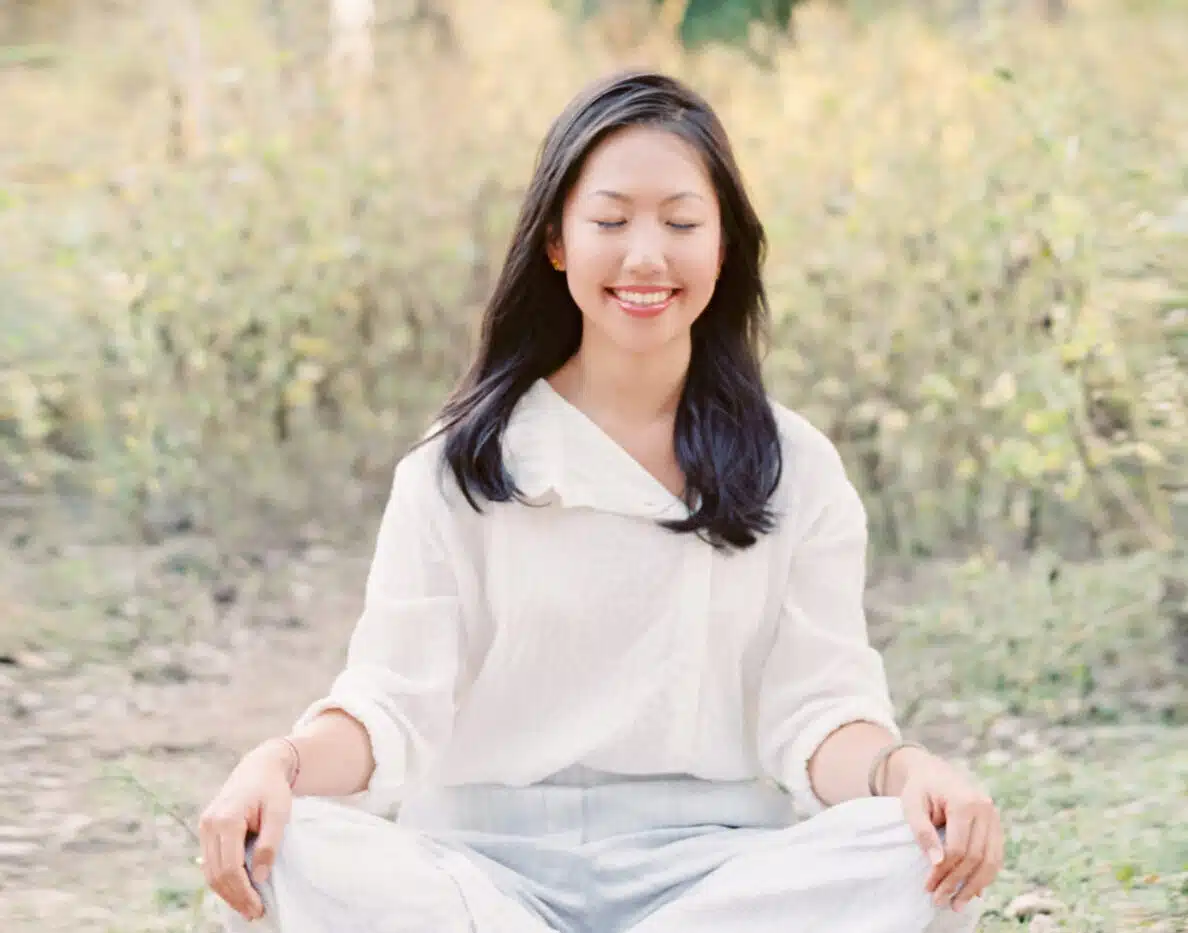How Meditation Works for Anxiety
Most people have felt the rush of panic when they come close to a road accident or miss the last step on a staircase. Sensations of panic are a normal reaction when the body is in imminent danger, but for many people, those sensations linger far after the threat has passed.
Meditation can help to calm the nervous system and body, and even help train an anxious person’s mind away from their panicked thought habits. But different forms of meditation affect anxiety differently, and very few can address the root cause of anxiety.
Vedic Meditation has the unique ability to address anxiety at the source by helping the body release stress memories and triggers from the body over years of consistent, twice a day practice.
In this article, we’ll review how meditation can help anxiety, and specifically how the Vedic Meditation technique uniquely addresses anxiety from the inside out.

What does anxiety feel like?
Since anxiety can appear in many ways– from overt panic attacks to a subtle unease in the back of the mind– it can be tricky to identify when stress is expressed as anxiety. Learning to recognize the symptoms can help an anxious person recognize when therapies and/or a supportive meditation practice would be a good next step.
If you’ve ever experienced uncomfortably racing thoughts, you have a sense of what anxiety feels like. People who deal with chronic anxiety may feel repeating thought loops that dominate their attention, or irrational fear or worry that persists once a traumatic or phobic memory is triggered. Others experience anxiety as a subconscious tension that causes their jaw, shoulders, or digestion to clench and function improperly. Feeling driven to distraction, busyness, relentless productivity, or obsessive behaviors can be signs of underlying anxiety as well.
In severe cases, people with anxiety may avoid certain situations, like those who stay in their own homes out of social anxiety. For the person with social anxiety, even going to the grocery store can be overwhelming. Others display avoidant behaviors from phobias, like driving over bridges or riding in an airplane. Still others have nervous habits like nail-biting, or superstitions like the need to keep certain objects on their person.
Many people with anxiety experience physical symptoms like sweating, trembling, dizziness, or rapid heartbeat. A person may not necessarily have anxiety if they show these behaviors: the point to note is that anxiety affects different people in different ways.
The Prevalence of Anxiety in the West
Chronic anxiety plagues an unusually high percentage of our society. According to the National Alliance on Mental Illness, “Over 40 million adults in the U.S. (19.1%) have an anxiety disorder,1” while “31.1% of U.S. adults experience any anxiety disorder at some time in their lives.2
The American Psychological Association describes anxiety as an emotion characterized by feelings of tension and worried thoughts and physical changes like increased blood pressure.3 The buildup of stress over time – whether emotional, psychological, or even physical – can create neural pathways in the brain habituating worry and anxious stress responses. An imbalance of chemicals in the brain may be involved, especially for those with chronic and long-term anxiety disorders.
Anti-anxiety medications are common, and while they may help an individual to feel more stable and calm, the anxiety will likely return once the medication is discontinued. Addressing the root of anxiety requires addressing the buildup of stress in the body.

Start your Meditation Journey Today
ATTEND A FREE INTRO TALK
The Vedic Perspective on Anxiety
According to the Vedic Worldview, anxiety signals an imbalance in the body, as are anger, sadness, fear, and depression. The emotions and conditions “turn on” with stress triggers in the physiology. Stress triggers different responses from person to person.
Where one person may express their stress and stress accumulation, another person’s default response to stress may be depression or reactiveness and anger. For someone who is prone to respond to stress with anxiety, any kind of stress trigger could result in panic, worry, or tension.
The Vedic Worldview posits that the mind creates thought forms to ‘think’ itself toward happiness. In other words, the mind attempts to get to a happier place or create a happier outcome by thinking. For the anxious person, their 60,000 to 100,000 daily thoughts are spent rehashing the past or future, to try to think their way toward more happiness and less stress. That’s what stress accumulation does to the mind.
How Does Stress Accumulation Work?
The Vedic perspective poses that stress accumulates each time we are not able to easily adapt to a change in expectation. Changes in expectations that create stress could be anything from a canceled appointment to a major accident or altercation. When a situation arrives that demands more resilience than we have available, we find ourselves in a fight or flight reaction. The heightened stress level affects every system in our bodies, especially when sustained over time.
While this stress response is occurring, the brain takes a snapshot of the circumstances and environment and associates that snapshot with the flood of stress chemicals and depleted physical resources. Our brains do a remarkable job downloading this information to help us avoid stressful situations in the future. So whatever we’re seeing, tasting, touching, smelling, feeling, or hearing… All of those inputs become future triggers to warn the brain that more stress is coming.
The Evolution of the Brain and Stress
This capability of the brain to associate triggers with stress was essential when we were dealing with life-or-death situations, like wolves, floods, and fire. Dealing with traffic and deadlines and relational demands works the same way… but instead of creating an occasional stress response that helps us learn useful information, our mind and body learn to trigger a stress response from circumstances that aren’t life-threatening. On the contrary, many of the triggers we learn to associate with normal, daily experiences.
Where does this leave the body? The body is then in a constant fight-or-flight state, with very little ability to adapt newly to changes. All of those 60,000-100,000 thoughts per day are spent strategizing how to avoid these stress triggers, and the body is not able to rest deeply enough to clear out the enormous backlog of stress accumulation.
Fast forward months or years after an extremely stressful event, like a car accident or breakup, and all of those sensory inputs that were present at the time will still trigger your brain into a fight or flight response. You hear the same sound of rustling leaves that was present during the breakup, and subconsciously your brain turns on an inexplicable fight or flight response.
The effect is that our past stress triggers begin to run our thoughts and behaviors, and even change our personalities. Rather than being free to make choices and be present in our experiences, these stress triggers dominate the conscious and subconscious mind.
We are not able to enjoy our natural state of happiness and bliss and are barely able to appreciate the pleasure of living each day. Instead, we’re trapped in reactions to weather and smells and body sensations, to tastes and sounds and things we see that relate in any way to a past stressful event.

CAN MEDITATION REDUCE ANXIETY?
The way Vedic Meditation works to address anxiety is different from other forms of meditation. The mantra brings the mind to more and more restful states until the body is in a deeper rest state than is even available in sleep. In that deep rest state, the body can release the accumulated stress memories that are causing the anxious thoughts. Over time, hundreds of thousands of stress memories can ‘unwind’ from the body during meditation, which is why it is among the most useful meditation techniques for anxiety.
As accumulated stress memories release with consistent practice, the mind will be able to use its phenomenal computing power to process something other than stress.
In a recent study4, 200 participants were introduced to a popular mindfulness meditation program and meditated for 45 minutes a day. Within two months of regular practice, the levels of stress reported by the participants decreased the same amount as the control group, who were given a generic form of a popular anxiety medication Lexapro.
“Anxiety as measured on a severity scale declined by about 30% in both groups and continued to decrease during the following four months.”
This is an encouraging study that shows the power of meditation as an equally effective treatment plan versus pharmaceutical options.
HOW TO MEDITATE FOR ANXIETY
There are many therapies and remedies that can help an anxious person feel less worry and panic. Therapy and trauma release are helpful, as well as the recognition of one’s triggers to intellectually choose to respond differently. Using guided meditation for anxiety can help reduce feelings of fear in the moment, like meditation music for anxiety can soothe turbulent emotions.
An important distinction here is that the sensation of fear, worry, or stress is a separate phenomenon from physiological triggers. All kinds of activities can help the sensations dissipate, though the trigger remains intact. Training the mind to choose to respond differently can even prevent the sensations from happening, but that technique depends on willpower and does not necessarily remove the stress memory in the body.
For example a person could have a lovely weekend of spa days, deep sleep, massages, and therapy, feeling spectacular and resilient by the end of the weekend. But if in the next week the person sees the same red Ford pickup truck that their ex-spouse drove, they will still think of them and may even feel the associated unpleasant emotions.
With Vedic Meditation, over time the very association with the red pickup truck will disappear from the mind and physiology, so the person is free from both the emotions and the cause of those emotions or worries.
Though there are important and helpful methods to feel less anxiety in the moment of a stress trigger, they may not necessarily unwind the root cause of the anxiety- the physiologically stored stress memory. Vedic Meditation can help to resolve the root cause of the problem alongside other therapies that soothe emotions and stabilize mental health. Vedic Meditation offers a sustainable and holistic way to address anxiety alongside other therapies that each individual finds helpful. As the body releases the stressors, the symptomatic anxiety can resolve itself.
CAN MEDITATION WORSEN ANXIETY?
There are many kinds of meditation, and some kinds will assist with anxiety more than others. For someone dealing with severe mental health challenges or obsessive thoughts, taking on a meditation style that requires concentration may only make them feel worried about ‘not thinking’ or ‘meditating incorrectly.’
The unique thing about Vedic Meditation is that thoughts are allowed during each meditation. This makes the meditation process effortless, which is a novel experience for an anxious mind. The anxious mind wants to control, predict, and avoid its circumstances. When the anxious mind then has a chance to allow thoughts easily and innocently, and then allow a mantra easily and innocently, they can experience a completely different state than the high-pressure state they usually feel.
THE BEST MEDITATION FOR ANXIETY
If you’ve never tried meditation before, or if you have tried but you find your thoughts have been too worried, feeling anxious, or busy to meditate, then the Learn to Meditate course will be a helpful experience. Over four days of 90-minute daily sessions, you’ll learn how Vedic Mediation works and start practicing with the mantra you receive.
Most people experience noticeable relief in anxiety within the first 1-4 weeks of beginning a Vedic Meditation practice. Many notice their sleep and stress resilience improves in the first week. With two meditation sessions per day, a meditator can address the stressors of the day and also address stored stress from the past.
Vedic Meditation is not a quick fix though: with the rate that we accumulate stress, it takes 8+ years to release a lifetime’s worth of accumulated stress. The daily practice is a process of incremental relief from more and more stress, making it a steady, reliable method to transform anxiety.

WHAT IS IT LIKE TO TAKE THE LEARN TO MEDITATE COURSE?
Here is how one student described their experience of the course in alleviating anxiety:
“I was having really bad anxiety and overwhelm as an entrepreneur. I was feeling really scattered and unsure of myself.
I felt like I was spinning in circles, getting nowhere. I was trying to control everything, looking for more things I should be doing. I felt like I was constantly paddling on choppy water, getting slapped by waves, and struggling to catch my breath.
What is different about Vedic Meditation vs. other things you had previously tried to solve your problem?
It’s easy in a sense. It’s like coming home. It’s a breath of fresh air. It has given me routine and familiarity.
It feels like surrender more than white-knuckling grip of control that I felt the other strategies were doing when I was just trying to wrangle things into submission.
What is different about Susan as a teacher?
Susan is phenomenal. I love that she is very practical and logical, and she offers a lot of science-based explanations. She is extremely down-to-earth and relatable and makes somewhat ethereal topics more easily understood.
She’s a WEALTH of knowledge and is so thorough and patient. She is always available if I have questions and is an amazing listener. I am continuously inspired by her.
She is an entrepreneur and her personal journey really resonated with me.
When did you know it was working?
When I started feeling my heart open up and feelings of gratitude and empathy come up in and out of the practice, I realized Vedic Meditation was actually working to solve my problem. Throughout my day I’m noticing I’m more deeply connected and present, and my empathy muscle is building.
I feel like I can handle more and help others more. Vedic Meditation feels like my restoration time.
I am still early on my Vedic journey (about 4 months) and I still experience stress and times overwhelm, but I feel so much more equipped and able to come back to my higher self in those moments. I feel like I can connect to others and myself more and really excited for what is in store as this journey continues.
– Ellie RomeTHE LEARN TO MEDITATE COURSE
Take the Learn to Meditate Course with Susan Chen to begin unwinding the deeply rooted stressors that keep your mind in an anxious state. Over time, you can feel the freedom of enjoying the present moment and trusting yourself to adjust to new circumstances as they come, with the tools in your pocket and the resilience to maintain your peaceful state. Learn more by checking out the latest Vedic Meditation news and frequently asked questions.
References
- Anxiety Disorders, NAMI: https://www.nami.org/About-Mental-Illness/Mental-Health-Conditions/Anxiety-Disorders
- Any Anxiety Disorder, NIMH https://www.nimh.nih.gov/health/statistics/any-anxiety-disorder
- Anxiety, APA: https://www.apa.org/topics/anxiety
- Mindfulness-Based Stress Reduction vs Escitalopram for the Treatment of Adults With Anxiety Disorders, https://jamanetwork.com/journals/jamapsychiatry/article-abstract/2798510






